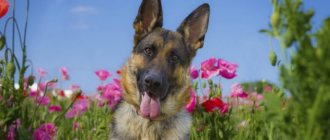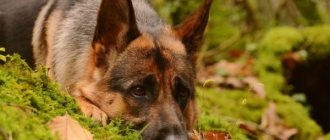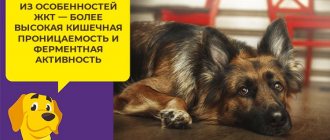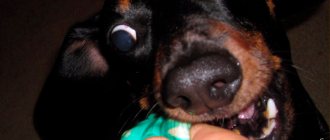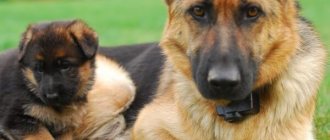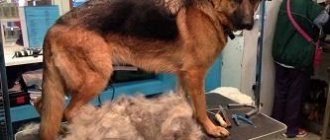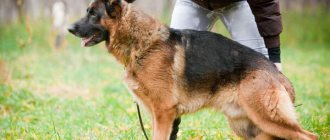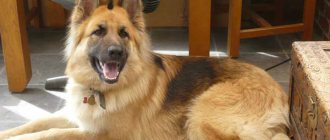Kinds
Most often, the owner can notice the first signs of dandruff when scratching and stroking the pet’s back, as well as the croup area. Manifestations of dandruff can be found behind the ears and on the neck. The appearance of the scales that appear on the skin will help to understand the causes of dandruff and methods of its treatment.
- If dead particles of epithelium easily fall off the fur, then we can safely say that dandruff is dry . This manifestation is accompanied by general dryness of the skin and dehydration. Dull fur is common with this type of dandruff.
- If the pet's fur fat, has an unpleasant odor, is often disheveled, or locally thinned out, then it can be stated skin disease. In this case, dandruff is small yellowish sticky lumps that get stuck on the fur and are difficult to comb out. The dog itches all the time, because skin diseases are accompanied by unbearable itching.
You can also divide dandruff by color:
- White - particles of dead skin. Often, white dandruff appears when hair is falling out or actively falling out.
- Black - so-called pseudo-dandruff. This is not exfoliation of the skin, but of blackheads and clotted blood. Such spots can appear on the skin due to serious disruption of the sebaceous glands and improper combing.
When combing, you can damage the bumps protruding on the surface of the skin, and they “fall off”. This gives the impression that it is black dandruff. This is a sign of hormonal imbalance, which can cause baldness.Common fleas are often confused with black dandruff!
- Yellow - usually a companion to seborrheic dermatitis.
- Red (pink) is not essentially dandruff, but pieces of skin that exfoliate from an infected, inflamed area of the skin due to dermatitis.
REFERENCE: The word “dandruff”, like many medical terms, is of Latin origin, and translated means “bran”
If your dog has severe dandruff, itching and hair loss
If your pet is constantly itching, has severe dandruff and hair loss, this may be a symptom of one of the following parasitic or fungal skin diseases.
Seborrhea
Dandruff in a puppy is sometimes the cause of the development of primary seborrhea. There is a breed predisposition to pathology. Those at risk include American Cocker Spaniels, Bulldogs, Basset Hounds and West Highland White Terriers.
In puppyhood, symptoms may be mild and ignored by the owner. Young animals have dull fur and dandruff.
In severe cases, excessive peeling of dead epidermal scales occurs, which is accompanied by excessive secretion of sebum with an unpleasant odor. Individual areas of the skin become inflamed, itching appears, and crust-like plaques form. The disease is dangerous due to the addition of a secondary infection and the occurrence of otitis media in dogs.
Secondary seborrhea is most often diagnosed in adult animals older than one year. Its development is provoked by internal pathologies and other types of dermatitis, including parasitic ones.
Seborrhea can be localized on any part of the body, but most often affects the base or root of the tail, the back of the body, the muzzle, neck, skin folds, and armpits.
Dermatophytosis
Belongs to a group of contagious dermatological diseases. Skin infections are caused by dermatophyte fungi. Yorkies and Jack Russell terriers are most susceptible to pathology.
With ringworm, the dog's hair falls out in places, most often in the area of the paws, face and head. Excessive peeling of the epidermis is visually noticeable. Pimple-like sores may appear.
Malassezia dermatitis
The pathology is caused by fungi of the genus Malassezia. Dermatitis is manifested by otitis externa in dogs, increased peeling of the skin, hair loss, local redness and itching. An unpleasant rancid odor emanates from the affected areas.
Demodicosis
Often diagnosed in puppies. Risk group: animals aged 1 to 10 months. Demodicosis in dogs is caused by demodex mites. Lesions appear on the back, paws, neck, and muzzle.
In some places, hair falls out, papules and pustules form, greasy dandruff occurs, which leads to the sticking of individual sections of hair.
Sebadenitis
It occurs against the background of inflammation of the sebaceous glands in the animal, which is accompanied by a deterioration in the quality of fur and skin. A sick dog develops alopecia, dandruff, and coat sticking as a result of disruption of normal keratinization.
The Akita Inu, Spaniel, Vizsla, Samoyed, Poodle and Havanese Bichon breeds are more prone to pathology.
Trichodectosis and Cheyletiellosis
Lice eaters are the causative agents of the parasitic disease trichodectosis. Clinical manifestations: hyperkeratosis of the skin, hair coming out, the dog itches, behaves restlessly, eats poorly. Lice eaters in dogs are often found at the same time as dog lice. During the life of parasites, animals may experience so-called “black dandruff”.
A characteristic symptom of cheyletiellosis is intensely growing hair. The second name for the parasitic disease is wandering dandruff. Other signs of the presence of cheyletiel: the animal is constantly itching, white scales are noticeable on the skin (see photo).
Stray dandruff is very common in Pomeranians, Chihuahuas, and Yorkies, since these breeds are in most cases bred en masse and uncontrolled. A new owner often discovers a parasitic disease after he has already adopted a puppy from the kennel.
Flea dermatitis
The owner may notice black dandruff on the pet, which is nothing more than a waste product of fleas.
Flea dermatitis is one of the causes of the development of skin allergies, manifested by itching and the formation of sores at the site of bites.
Causes
Why does this problem arise? Dandruff itself does not always clearly indicate a malfunction in the dog’s body. There can be many reasons for its appearance, from a simple change in food or an unsuitable indoor microclimate, to serious damage to the skin by mites. To understand where dandruff comes from, you need to observe your pet.
Why does dandruff appear in dogs?
- Seasonal dandruff on the back during hair loss (molting) is a common phenomenon.
Most dogs live in apartments with central heating, which greatly affects air humidity. As soon as the air becomes drier than usual, shedding begins, which is accompanied by dry dandruff. Usually it goes away when the coat change ends. To alleviate your pet’s condition, you need to comb its fur more often, and also use conditioner when bathing. You can purchase an air humidifier - this will be useful not only for your pet, but also for other inhabitants of the apartment. - If the dog is constantly itching , then dandruff on the coat becomes even more noticeable, especially on the back. There can be many reasons for itching. This is either a food allergy, or a reaction to the bites of blood-sucking insects, or the first manifestations of eczema, seborrhea or other types of dermatitis. Skin parasites can also make themselves felt by unbearable itching.
- Stress . Dogs react differently to the world around them, and some are more susceptible to stressful situations. Stress can be anything - separation from the owner, boredom, fear, and much more. A dog can easily begin to itch due to nervousness, and it is the owner’s duty to protect his friend from nervous shocks.
- Scratching, sores, thickening of the skin in these places, severe oily dandruff, in which a lot of hair climbs and falls out - an unambiguous signal from the dog’s body about a skin disease. This could be atopic dermatitis, allergies, seborrhea, scabies, demodicosis and many other infectious and unpleasant diseases for the dog. If your pet is in this condition, you should never postpone a visit to the veterinarian!
- If the dog behaves as usual , but dandruff is normal for it, then it is worth thinking about how high-quality nutrition the pet receives.
Economy class food, food from the master's table, fatty, salty, sweet - all this should be prohibited. When choosing food, it is best to pay attention to premium food that contains the optimal amount of essential nutrients and vitamins. A good alternative to ready-made food can be preparing your own food for your dog. - A nonspecific cause of dandruff in a dog can be improper hair care, too frequent or, conversely, too infrequent washing, or inappropriate shampoo.
REFERENCE: The PH level of a dog’s skin is 8, while a human’s is 5.5.
Instead of the owner's shampoo and conditioner, when bathing your four-legged friend, you need to use special products intended only for dogs.
The main causes of dandruff in dogs
Dandruff is a natural death and exfoliation of epidermal cells. The word is translated from Latin as “bran”. Peeling is a normal process that accompanies not only dogs, but also people throughout their lives. The alarm should be sounded when there are too many white flakes of dead cells.
There are two types of dandruff discharge: dry and oily . By identifying a specific type, you can find out the cause. Dry dandruff indicates that your pet's skin is not getting enough fluid or is drying out from the heat. Oily skin appears as yellow plaques on the skin; it often leads to severe hair loss and itching and indicates problems with the sebaceous glands.
The causes of dandruff may lie in internal infectious or autoimmune processes or in external irritating factors.
- The most harmless and quickly solved problem is dry air in the room where the dog is kept . This often happens during the cold season, when artificial heating is turned on in houses. The air heats up and dries out, making it difficult for your pet to breathe, and the skin deteriorates and peels. In this case, you need to purchase a humidifier.
- Improper or incomplete nutrition leads to a depletion of the balance of vitamins in the body and improper functioning of all organ systems, including the epidermis. It is important to take into account the characteristics of individual dogs, their allergies, preferences and develop a diet taking these criteria into account. You cannot rely on cheap ready-made food; they contain flavorings and other components that cause dermatitis and irritation.
- Stressful situations often affect not only the mental health factor, but also the physiological one. Pets that are often alone at home, do not go for walks much, and do not interact with other animals often suffer from stress. This is also one of the reasons due to which excessive peeling of the skin occurs.
- Poor quality water , untreated thermally. Dogs, like children, need clean water. They must be supplied with bottled or filtered water. This will not only help protect against worms, but also improve the general condition of the animal.
- Parasitic diseases . Often, dandruff is caused by tick and flea bites.
- Incorrect, irregular, too frequent bathing . Dandruff is caused by the use of human shampoos, frequent water procedures, and the use of rough combs that injure the skin.
- Hormonal imbalances and internal diseases (eczema, diabetes).
Dandruff on the back
Dandruff is rarely localized to one area of the skin, and if this happens, then as the disease develops it spreads over the entire area of the skin. Peeling that appears first on the back indicates a possible parasitic infection. Often fleas and ticks cause dandruff along the ridge.
Swimming in hard water or with the wrong products also often causes flaking on the back.
By the tail
Since dandruff is rarely localized, it is possible that the appearance of flaking at the tail is a symptom of a flea or tick infestation. Before establishing the main cause, you need to remember whether your pet’s diet has changed recently, what it was bathed with, and for how long ago. It is important to analyze all possible factors and take the animal to a veterinary clinic to make an accurate diagnosis.
Black dandruff
It is black dandruff that does not exist. Therefore, such peeling is called pseudo-dandruff. Often, flaking is confused with a large number of fleas and their secretions. Also, dandruff of this type may turn out to be dried droplets of blood (if the comb injured the skin or the sebaceous glands do not function correctly).
If accompanied by hair loss
Any severe peeling can be accompanied by loss of guard hairs, because dead scales of the epidermis block and clog the pores, causing the hairs to quickly die.
Sometimes dandruff accompanies the molting process in an animal. The owner must know during what periods his dog actively changes its coat, so as not to miss the possible occurrence of the disease.
Hair loss can be caused by fungal or autoimmune diseases. The pet may lack certain microelements (zinc, ascorbic acid). Another reason that Spaniels often suffer from is adenitis of the sebaceous glands. Sometimes out-of-season shedding is caused by ticks and fleas.
Dandruff and itchy skin
Itching is a symptom of a disease; in order to get rid of it, you need to find and treat the root cause. If a dog is found to have dandruff, the animal itches a lot, the first thing to do is to examine it for the presence of fleas and ticks. This is one of the most important reasons.
Scabies can also be caused by a fungus or bacterial dermatitis. If the microflora on the surface of the epidermis is normal, then most likely the severe itching is caused by an allergic reaction.
Sores with dandruff in a pet
If the appearance of dandruff is accompanied by wounds or painful growths on the dog’s skin, then this is a clear symptom of dermatitis or other epidermal disease:
- Atopic or allergic dermatitis;
- Scabies (sarcoptic mange) is a disease caused by a certain type of mite;
- Lichen;
- Ectoparasites (fleas, ticks, lice eaters).
In addition, wounds can form due to the fact that the pet is constantly itching and tearing the skin. This is dangerous, because it opens a direct path into the body for bacteria and infections.
Treatment
How to get rid of dandruff? In order to select adequate treatment, it is important to find out the cause of its occurrence. You shouldn’t do this on your own; it’s best to trust a veterinarian who can professionally examine the dog, take all the necessary tests and skin tests.
When a diagnosis is made, it is much easier to act - the owner just needs to build on it.
How to withdraw:
- What to do if your dog itches like a mangy pig? Kill the parasites! It is necessary not only to bathe the dog using special shampoos, but also to disinfect everything that has ever touched the dog. Brushes and combs should either be thrown away or boiled.
- The dog is stressed . It is important to understand whether the trouble was a one-time occurrence, or whether the animal is subjected to constant stress. The peace and safety of the dog is entirely in the hands of the owner.
- Simple dry skin, then you need to take measures to moisturize it. You can use balms-rinses for dogs, or herbal decoctions; the fur and skin should be massaged with a soft comb or brush.
- Dermatological diseases, it is important not only to consult a doctor on time, but also to follow all his instructions.
By the way, dandruff is a very strong allergen, so asthmatics should refrain from interacting with a dog that has a lot of dander.
And one more thing: it doesn’t matter where exactly the dandruff is - on the back, ears, tail or neck, the set of measures of what to do, treatment and causes will be the same!
Shampoos
How to treat dandruff simply and cheaply: every owner regularly bathes his pet, so if dandruff occurs, it is imperative to change the shampoo to a more suitable one.
- Such a shampoo should contain emollient components, for example, aloe, oats or vitamin A. These can be found in the brands Espree, Fitoelita, 8in1.
- If you suspect skin parasites, then you should pay attention to anti-itch shampoos with an insecticidal effect . Hartz Rid Flea & Tick shampoo with oats, panthenol and vegetable oils showed good results in the fight against parasites.
- Shampoo for dogs with sensitive skin is also in the line.
- Antifungal shampoos for dogs: Nizoral, Imaverol, Doctor. The latest domestic drug is also good for combating skin mites.
Mud fight: how often and with what can you wash your dog?
Vitamins
What vitamins and supplements should you give your dog:
- dried seaweed - a rich source of microelements, normalizes metabolism, improves pigmentation of the outer integument;
- nettle - its finely chopped leaves are added to food (both fresh, after processing with boiling water, and dried) as a source of vitamins to improve wool growth;
- ground flaxseed is a healthy supplier of fatty acids. Grind them in a coffee grinder and periodically add the resulting powder to the dog’s usual food;
- Wheat germ is a storehouse of vitamins B and E and will improve the condition of the skin. In winter, you can sprout wheat grains on the windowsill and treat your pet to them.
Folk remedies
What to do if your pet has dandruff? You can turn to folk knowledge! To treat dandruff and related problems, you can use herbal decoctions.
A decoction of chamomile will help soothe irritated skin, and herbs such as wormwood, yarrow or tansy will repel parasites from the dog’s bedding.
BUT: treatment of dandruff should be carried out under the strict supervision of a veterinarian, and medicinal herbs can be used as additional therapy, but do not replace drug treatment prescribed by a doctor.
The right treatment for dandruff removal
Treatment for severe peeling directly depends on the cause of its appearance..
- If the pet’s condition remains normal, the temperature does not rise, it is not bothered by itching, and no wounds appear, then most likely you need to change the shampoo or change the diet. Otherwise, it is important to visit a veterinarian to establish a diagnosis.
- To defeat dry dandruff due to unhumidified air, you just need to install a humidifier that will condense steam.
- If your pet is under severe stress, you need to provide him with frequent walks and exercise.
To treat diseases accompanied by peeling, the veterinarian will prescribe highly targeted medications. In addition, there are shampoos that reduce dandruff.
Review of the best anti-dandruff drugs and shampoos
The action of anti-dandruff drugs is aimed at cleansing the skin of scales, soothing itchy areas and sometimes getting rid of ectoparasites. Shampoos often contain the following compounds: sulfur, tar, salicylic acid, benzene peroxide.
- Doctor shampoo is often used in the treatment of epidermal diseases. The drug normalizes the functioning of the sebaceous glands, the production of secretions, reduces inflammation, relieves itching, and cleanses the skin of dandruff. Use it once or repeat it after 2-3 days. The average price is 150-260 rubles (depending on the additives and bottle size).
- Frontline is a product, available in the form of sprays and solutions for external use, that helps eliminate endoparasites. In addition, it improves the general condition of the skin and coat and is used once. The price of external drops is 220-400 rubles, the price of a spray is 430-700 rubles.
- Stop Itching is a spray used to soothe itchy skin. Used in the complex treatment of dermatitis. Cost – 300-400 rubles.
- Anti- Dandraff - shampoo, used to wash away dry dandruff from the skin of an animal, contains calendula oils, suitable for animals with sensitive skin. Cost – 900-1000 rubles.
- Shampoo “Lugovoi” is a preparation based on natural ingredients, has an anti-inflammatory effect, cleanses the epidermis of dead cells. The average cost is 169-200 rubles.
Use of folk remedies
Peeling skin, which is not a symptom of an infectious disease, can be treated by using plant-based folk remedies. Like industrial preparations, traditional methods are aimed at relieving the pet of itching, reducing inflammation, and cleansing the skin.
- Olive squalene is applied twice a day, relieves irritation, heals microcracks, softens and soothes the skin. The product is odorless and does not leave a greasy film on the coat.
- Almond oil and lavender (can be replaced with eucalyptus), the resulting mixture is applied between the shoulder blades or on the scruff of the neck as a regular antiparasitic agent. Use daily for up to 2 weeks. The product fights parasites.
- Decoctions of wormwood or tansy . They are used as shampoos during water procedures. Helps in the fight against fleas and ticks.
Preventive actions
Of course, it is best not to treat the disease, but to prevent it in advance. To summarize, we can say that all skin diseases, be it dandruff, itching or inflammation, are caused either by internal health problems of the animal or by parasites.
- Preventing diseases is quite simple; it is only important to monitor your pet’s diet, feed it with high-quality food, treat it for parasites in a timely manner and keep an eye on where your four-legged friend walks.
- The psychological component is no less important. You need to play with the dog more, communicate with it, train it. Such a social animal as a dog does not know how to be alone.
Cheyletiellosis
Cheyletiellosis is a skin disease named after its causative agent, the Cheyletiella mite. It is also called stray or wandering dandruff. There are many varieties of this mite, and it feels great on the skin of cats and dogs, as well as rabbits, chinchillas and other furry neighbors of humans. This small parasite feeds on tissue fluid, piercing the skin, which subsequently itches severely.
IMPORTANT: The tick is contagious to humans, but it is not capable of living on human skin for a long time. But even a short contact is enough to provide the owner of a sick dog with unpleasant itchy skin rashes.
The tick is a parasite, which means it cannot exist without a host. The period of “independent life” of a female tick lasts up to 10 days, and the male lives only 2 days. Eggs laid in a dog's bedding will be viable for about a week.
How to recognize?
The popular name for this disease is “stray dandruff”, since the mites are very similar to flakes of dead skin cells. Moving from place to place, they create the illusion of dandruff moving, which can frighten the owner. Sometimes diagnosing cheyletiellosis in a dog is difficult, especially if the owner regularly bathes and combs the dog's fur.
There are a number of symptoms by which this disease can be identified.
- Copious flakes of dandruff,
- Excessively oily skin
- Tousled and oily fur,
- Partial hair loss
- Skin redness,
- Obsessive itching and scratching.
ATTENTION: The tick can live in the nostrils of the animal, so the alarm signal can be the pet's sneezing and discharge from its nose.
To be fair, it is worth noting that these symptoms are very similar to the symptoms of many other skin diseases. A veterinarian can determine cheyletiellosis by scraping the skin and conducting a laboratory test.
How to get sick?
Dogs are social creatures, so it is not difficult for them to become infected with cheyletiellosis. It is enough to simply play with a sick dog, and sometimes just lie down on the bedding on which the sick animal was previously lying.
Long-haired dog breeds are more susceptible to the disease, as are dogs with weak immune systems. You can also become infected after visiting a groomer if the latter does not pay due attention to sterilizing his tools and hygiene.
Is it contagious to humans?
Cheyletiellosis is easily transmitted to the owner of a sick dog, and is localized in places of contact with the dog, most often on the hands. Fortunately, the parasite cannot live for long on human skin and dies quickly enough, so specific therapy is not necessary. If you do not comb the affected areas, you can avoid skin damage and associated infections. Emollient creams or a soda solution will help cope with itching.
How to remove?
How to treat this infection? First of all, it is worth remembering that only a veterinarian can make a correct diagnosis, and he must prescribe appropriate treatment for cheyletiellosis. You shouldn’t delay going to the doctor, because a parasite on the skin causes itching and scratching, and scratching, as you know, is a direct path to infection.
If there are other animals living in the house with a sick dog, then everyone will have to be treated for ticks. Long-haired dogs will have to be cut, because this makes treatment much easier. The course of treatment for wandering dandruff, i.e. Cheyletiella mite life is long – about 8 weeks.
- It is important to combine treatments for cheyletiellosis with constant wet cleaning of the house, otherwise re-infection cannot be avoided. All bedding, furniture covers, curtains and even bedding should be disinfected to reduce the risk to zero.
- Dogs are bathed using acaricidal shampoos (for example, “Dana”), and tick eggs are carefully combed out of their fur, since the drugs destroy only adult individuals. In addition, the tick can go into hibernation mode and become active after all the procedures have been completed, so combing is necessary.
- After bathing and brushing, you need to apply drops to the withers . Veterinarians usually prescribe Dana drops, Advantix, Advocate and similar drugs.
- Sulfur ointment can be very effective in the fight against scratching , which is completely harmless to the pet even if swallowed.
- In case of severe disease, the veterinarian may prescribe subcutaneous injections of drugs , depending on the condition of the animal.
Seborrhea or seborrheic dermatitis
Seborrhea is a typical problem for the following breeds: Cocker Spaniel, West Highland White Terrier, German Shepherd, Shar Pei.
Seborrhea is excessive oily skin and/or its rapid growth. In a dog suffering from seborrhea, the skin can grow, creating successive layers of skin 2-3 times faster than in a healthy dog. The top layer of skin is actually dead and is called the keratinized layer or stratum corneum, consisting of thin scales, completely keratinized (keratinized), capable of peeling off and thus detaching.
The cause of skin seborrhea in a dog is quite difficult to determine, as is the origin of any dermatitis. Some scientists are inclined to believe that this disease is of a genetic nature; others say that seborrhea develops as a secondary disease against the background of dysfunction of the sebaceous glands.
Dysfunction manifests itself in excessive activity of the sebaceous and sweat glands, and is accompanied by inflammation.
Symptoms
- Most often, at the initial stage, seborrhea manifests itself as dry or oily dandruff.
- a distinct dog smell appears , even after bathing. If the symptoms are left unattended at this stage, over time, redness and scratching will appear on the dog’s body, the skin will crack, and the claws will become brittle.
- A secondary infection occurs precisely at this moment, because the owner cannot convince the dog not to itch, and the infection spreads precisely through scratched, injured skin.
- Seborrheic dermatitis can be caused by several other factors, such as allergies. In this case, the veterinarian will treat the underlying cause.
Photo
Seborrhea of the edges of the ears
Fat
Since seborrhea manifests itself precisely in the form of dysfunction of the sebaceous glands, its signs are looked for where the dog has the most of them, namely, along the spine. You need to be wary if you find:
- Dandruff and dry skin,
- Greasy dull wool,
- Redness on the skin.
If you suspect seborrhea, you need to carefully examine the dog and check all skin folds and folds, because it is in these places that the infection begins.
Is it possible to get infected?
Despite the terrifying appearance of a sick animal, it is not dangerous to surrounding people and animals. The cause of seborrheic dermatitis lies internally, and it cannot be infected.
How to treat?
- Treatment of seborrheic dermatitis should be comprehensive and include, first of all, veterinary diagnostics . After taking tests, the doctor will determine whether there is any pathology of the internal organs that could cause a skin disease.
- Doctors then test the dog for fungus, parasites, or bacterial infection . Tests can also be used to determine whether a dog has allergies . If no diseases were found during diagnosis, then treatment of primary seborrhea is prescribed.
Unlike secondary seborrhea, primary seborrhea is considered an incurable disease, and therapy in this case will be aimed at improving the condition of the skin and preventing relapses.
Secondary seborrhea usually goes away on its own after the root cause is eliminated.
In both cases, it is important to know which drugs are used for treatment:
- For hair and skin care, antiseborrheic shampoos , which should be prescribed by a doctor based on the condition of the animal’s skin. The most universal can be considered “Tropiclin” and “Doctor” for oily seborrhea, and “Medicinal”, “Agrovetzaschita”, “Globalvet” for dry seborrhea. Your veterinarian may prescribe a special fluconazole shampoo for a fungal infection. ATTENTION: Shampoos with fluconazole cannot be used more than twice a week and longer than 3-4 weeks!
- After washing your dog, you should use conditioners with lanolin or oil for additional moisture. You can use special antipruritic ointments , they will significantly alleviate your pet’s condition.
- If an infection is associated with seborrheic dermatitis, then in this case the doctor will prescribe oral antibiotics, most often drugs containing amoxicillin. IMPORTANT: After a course of antibiotics, it is imperative to take a course of probiotics to support the dog’s digestive tract.
Diet
Since seborrhea is, in principle, incurable, it is important to choose a diet for your four-legged friend, which he must adhere to throughout his life. If the diet is chosen successfully, then seborrhea will go into remission and will not bother the pet.
The diet must include vitamins and mineral supplements, which are responsible for stimulating metabolic processes in the skin. If you wish, you can choose a ready-made diet or cook your dog’s food yourself.
The essence of the disease
Dandruff can appear at any time of the year and at any age. The length of the fur does not matter; the problem can occur even in a short-haired or bald pet. The disease is pronounced in the neck, area behind the ears or along the spine.
There are two types of disease:
- Oily (seborrhea). The work of the sebaceous glands increases several times, so the skin becomes oily. The dying skin flakes have a yellowish tint. Severe hair loss may begin.
- Dry. The skin is dry, very flaky, skin particles fall off when combed, the peels are small.
Over time, the disease spreads more and more, causing general discomfort and severe itching.
Conclusion
To summarize, it is worth noting that:
- Proper grooming of your dog will help prevent skin problems,
- A balanced diet will not only give your pet a thriving appearance, but also health,
- For any problems with the skin and coat, you should immediately contact a veterinarian, otherwise treatment will be difficult and lengthy,
- Comprehensive treatment works best.
Coping with skin diseases is not easy, but if you put in the effort, coupled with love for your pet, the result will be amazing and will not take long to come. How did you treat your pets? Share your stories in the comments!
My dog has dandruff - what to do?
How to remove dandruff from a dog? – first of all, the owners of their faithful four-legged friends try to find answers to this question.
The best treatment option for this disease is high-quality diagnosis. None other than a veterinarian, using his professional skills, will be able to correctly identify the cause of dandruff and draw up a treatment plan and valuable recommendations. He may recommend an anti-dandruff shampoo for dogs that will help eliminate the problem. Herbal balms and ointments can be used as rinses and infusions, the natural ingredients of which will quickly get rid of dandruff.
By reacting quickly and taking timely measures, you can quickly help your pet fight dandruff and eliminate the feeling of discomfort.
